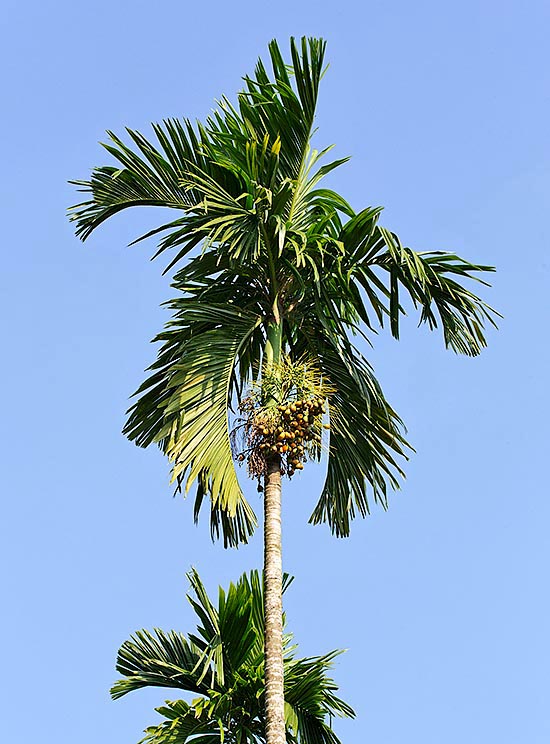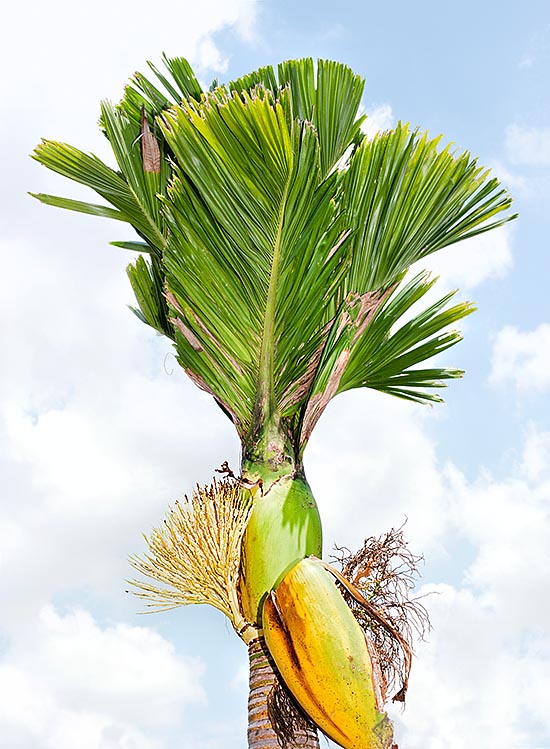Family : Arecaceae

Text © Pietro Puccio

English translation by Mario Beltramini

Areca catechu seeds are often chewed wrapped in betel leaves © Giuseppe Mazza
Cultivated since remote times, the exact origin place is unknown, probably the humid tropical forests of Malaysia.
The name of the genus is the Latinization of the local name of an Indian species belonging to the genus; the name of the species is the Indian one attributed to several astringent substances.
Common names: areca palm, areca-nut, areca-nut palm, betel nut, betelnut palm, catechu, Indian-nut, pinang palm (English); bin lang, bing lang (Chinese transcribed); supaadii, supaarii (Hindi); arec cachou, arec de l’Inde, arèque, arèquier (French); areca, palma areca (Italian); pinang (Malaysian); areca catecú, arequeira (Portuguese); areca, bonga (Spansh); Betelnuß Palme, Betelpalme, Catechu Palme (German).
Areca catechu L. (1753) is an unarmed monoecious specis with thin single stem, 10-20 cm of diameter, erect, up to 20 m and more tall, grey, dark green in the youngest part, on which are well visible, due to the whitish colour, the rings trace of the attachment of the fallen leaves.
The 8-10 leaves, on an about 5 cm long petiole, are pinnate, arcuate, up to 2 m long, with the foliar base wholly wrapping the trunk for a height of about 1 m forming a sort of a tubular capital with a slight swelling in the lower part. The glossy intense green pinnules, in number of 20-30 per side, are of not uniform breadth and indented at the extremity, in the median part 40-60 cm long and 3-10 cm and more broad with 2-4 close pleats and inserted along the rachis in way to form a ‘V’ profile of the leaf.
Ramified inflorescences under the leaves, yellowish, about 30-50 cm long, carrying cream white flowers, perfumed, of both sexes, arranged in the characteristic triad (a female flower amidst two male ones), in reduced number and confined to the base of the rachillae (secondary rachis in the ramified inflorescences), and only male flowers, arranged alternate on two opposite lines, in the remaining part.
The fruits are oblong or ovoid fibrous drupes, 4-6 cm long and of 2-4 cm of diameter, of colour from orange yellow to red when ripe, containing only one seed. The seeds (fresh) germinate in 3-5 months at a temperature of 24-28 °C, with adjacent germination and first leaf bifid; the growth is quite fast in the best conditions of cultivation and the first fructification takes place around the 7th year of age.
From 2022 Areca catechu is inserted in the category LC, Least Concern of the Red List of the International Union for Conservation of Nature (IUCN).

Many horticultural forms of Areca catechu are born, like this compact variety in bloom © Giuseppe Mazza
Very ornamental species due to the thin stem surmounted by an elegant crown of curved leaves, it needs warm climate and high and constant humidity, atmospheric as well as in the soil, is therefore suitable for being cultivated in the humid tropical zone with annual rainfall over the 2000 mm regularly distributed during the year, where this is lower and in the climates with dry season it must be irrigated.
It grows in an ample variety of soils, provided well drained, with preference for the acidic and neutral and rich of organic substance ones, with temperatures over the 14-15 °C, even if it can stand, for a quite short period, isolated drops of temperature up to + 5 °C. In the juvenile stage it likes a partially shaded position, when adult the full sun. In pot, at the juvenile stage, it can be utilized for the decoration of luminous inner spaces and often is sold, with the seed partially interred and one or two leaves, as “mini coconut” due to the resemblance to a miniaturized coconut (Cocos nucifera).
Rather than for its ornamental characteristics, it is widely cultivated in all south-eastern Asia for the widespread use of the “betel”, that is of the seeds, which, cut in thin slices, are chewed wrapped in leaves of betel (Piper betle), with addition of lime and possibly of leaves of tobacco and other aromatizing substances.
The endosperm contains, besides the tannins, several alkaloids, among which the arecaidine, which acts as lenitive and mild narcotic and, above all, arecoline, highly toxic substance, which has a stimulating action on the skeletal musculature and on the central nervous system.
Despite the many negative collateral side effects, at the level of the mouth, the most serious being the appearance of tumours, as well as of the whole organism, the use involves large segments of population, estimated around the 5% of the world one, and consequently this palm stands at the centre of an intense commercial activity, in Taiwan it is even in second place in the agricultural products. Numerous varieties are cultivated which differ mainly for the quality of the fruits and the production, and also, for ornamental purposes, due to the size and the colour of the trunk, of the foliar sheath and of the fruits.
Since remote times, the seeds are utilized also for their vermifuge properties in the man as well as in the animals. All the parts of the plant are variously used in the popular medicine, furthermore the fruit furnishes a colourant and the inner core of the vegetative apex (palm heart) is consumed as vegetable.
Synonyms: Areca cathechu Burm.f. (1768); Areca faufel Gaertn. (1788); Areca hortensis Lour. (1790); Sublimia areca Comm. ex Mart. (1838); Areca himalayana Griff. ex H.Wendl. (1878); Areca nigra Giseke ex H.Wendl. (1878).
→ For general notions about ARECACEAE please click here.
